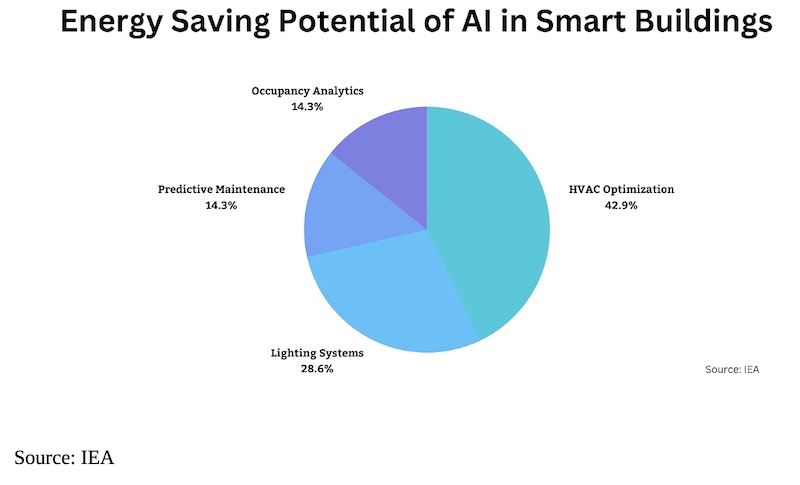The big data analytics market in the building energy sector is expected to grow at a Compound Annual Growth Rate (CAGR) of 11.28% during 2021-2026. With such a promising growth trajectory, it’s clear that AI and data analytics are not just buzzwords. They are revolutionizing how we manage and operate buildings. But how exactly are these technologies turning raw data into actionable insights?
Smart Building Applications: Turning Raw Data into Actionable Insights
The latest technologies like information and communication, sensing and measurement, and cloud computing, are being integrated. With the help of these, large amounts of building automation and management data are being produced. Which in turn is revolutionizing conventional Building Automation and Management Systems (BAMSs).
AI and machine learning algorithms help make sense of this massive amount of data. Smart building sensors collect information on temperature, humidity, occupancy, and energy usage.
This includes data from HVAC and lighting systems, security cameras and access control systems, elevators, solar panels, EV charging stations, and more. AI systems identical to the building analytics platform CIM then process this raw data from disparate systems to uncover patterns and anomalies.
For instance, AI can analyze office occupancy data from security cameras and access control systems to optimize HVAC settings for different zones, reducing energy waste.
As another example, AI can track usage patterns of elevators and escalators to schedule predictive maintenance and repairs during low traffic periods. AI is also being used to monitor output from solar panels and EV charging stations and optimize their performance.
By regularly analyzing all this data, AI systems can make automatic real-time adjustments for optimal comfort and efficiency. This includes actions like tweaking temperature setpoints, dimming lights, and modifying ventilation rates based on occupancy changes. The power of AI lies in its ability to convert raw data into insights for predictive and adaptive building management.
While the ability to gather and analyze data is transformative, the real magic lies in predicting future needs. This brings us to one of the most game-changing applications of AI in building management: predictive maintenance.
According to research by the International Energy Agency (IEA), AI-driven smart building management can reduce a building’s energy usage by 10-30%. Here is a breakdown of the potential energy savings by application:

Predictive Maintenance: The Game Changer
Among the most transformative applications of AI in smart buildings is predictive maintenance. AI-enabled analytics tools allow building automation systems to continually monitor equipment performance across HVAC, electrical, plumbing, conveyance, and other systems. By analyzing reams of past data, AI algorithms can forecast problems before they occur.
For instance, AI can detect worsening pressure, vibration, temperature, leaks, corrosion, and other indicators of impending equipment failure. Instead of “break-fix”, issues can be addressed proactively before they disrupt operations. This avoids the high costs of unplanned downtime and catastrophic system failures.
In a chiller for example, AI analyzes flow rates, condenser pressure readings, oil samples, acoustics, and temperatures over time to predict deterioration issues early. Operators can then service the chiller preemptively, optimizing capital planning and maintenance workflows. The data also enables intelligent Parts Inventory Management.
Transitioning to predictive maintenance driven by AI analytics drastically reduces operating cost. It cuts unplanned outages, reactive repairs, equipment downtime, and premature replacements. Additionally, enhances occupant comfort and productivity by minimizing disruptions. The AI-enabled future of maintenance is already here.
Challenges and Opportunities in the Transition to AI-Driven Smart Buildings
The limitations of existing building automation control systems pose a major challenge. Most were designed without data analytics and AI in mind. Integrating these capabilities into outdated systems is complex and costly. The potential strain on networks due to the surge in data from sensors and meters also needs to be addressed.
Additionally, while data collection is becoming all-embracing, challenges persist, especially for outdated buildings. The main challenges include obsolete technologies and conventional error-prone data collection methods.
The key opportunity lies in viewing all this data as an essential asset for core business operations rather than an inconvenience. This shift in perspective allows CEOs and CFOs to leverage insights from AI and data analytics for informed decision-making on budgets, investments, and strategy.
While challenges persist, the potential benefits of AI in building management are undeniable, especially when it comes to sustainability. Let’s explore how AI is leading the charge in energy sustainability and ESG initiatives.
Leading the Charge: Energy Sustainability and ESG Initiatives
AI adds entirely new dimensions to building automation by enabling autonomous and continuous data analysis to optimize operations. AI-based solutions have emerged as indispensable tools for tackling energy sustainability challenges.
AI algorithms can forecast occupancy and adapt lighting, cooling, and ventilation needs to minimize energy waste. Energy models powered by AI can optimize heating and cooling equipment scheduling and settings for maximum efficiency. Building-to-grid integration allows AI systems to shift non-essential loads to off-peak times based on demand signals, reducing peak charges.
AI can also optimize renewable energy usage. For instance, AI can schedule EV charging for fleet vehicles during solar peak generation. It can also predict renewable output based on weather data and balance on-site generation with grid power.
These capabilities allow operators to align building energy behavior with larger corporate sustainability goals and ESG initiatives. With access to granular real-time data, AI systems can provide detailed insights to continuously improve efficiency, ultimately enabling buildings to achieve net zero carbon targets.
Frequently Asked Questions
Q1: How do AI and data analytics ensure the environmental sustainability of smart buildings?
AI and data analytics enable continuous monitoring and adjustments to minimize energy usage while maintaining optimal thermal comfort and air quality. The insights help facility managers reach sustainability goals.
Q2: What are the potential risks or challenges associated with integrating AI into building management systems?
Potential risks include network strains from increased data, integration issues with legacy systems, and dependence on AI for decision-making. Proper planning and governance can help navigate these challenges.
Q3: How do predictive maintenance and real-time adjustments contribute to cost savings in smart buildings?
Predictive maintenance reduces equipment downtime and replacement costs. Real-time adjustments optimize energy use, lowering utility bills. Together they significantly improve the bottom line.
Conclusion
The statistics paint a clear picture – AI and advanced analytics are driving a revolution in smart building management and sustainability. From predictive maintenance to energy optimization, the possibilities are limitless. AI turns raw data into powerful insights that enhance efficiency, lower costs, elevate occupant experience, and reduce environmental impact.
However, to tap into the immense potential, building owners must thoughtfully navigate the transition by upgrading infrastructure, centralizing data, building analytics teams, and rethinking business models. Although the path brings complex challenges, the prize of AI-driven smart buildings is too great to forfeit. With sound strategy and execution, this new era will soon become a widespread reality, leading to a more efficient, sustainable, and comfortable built environment.




